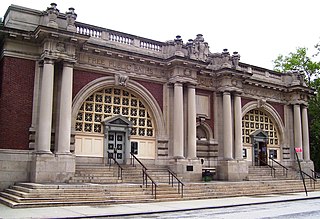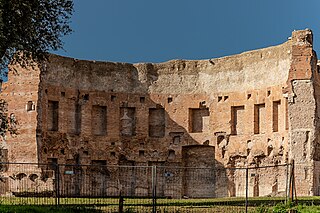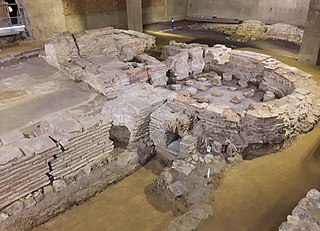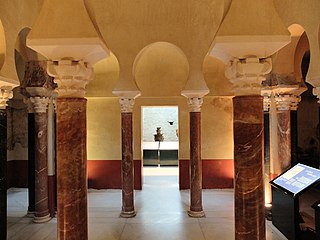
A bathroom or washroom is a room, typically in a home or other residential building, that contains either a bathtub or a shower. The inclusion of a wash basin is common. In some parts of the world, a toilet is typically included in the bathroom; in others, the toilet is typically given a dedicated room separate from the one allocated for personal hygiene activities. In North American English the word 'bathroom' is sometimes used to refer to any room in a residence that contains a toilet, regardless of the inclusion of a bath or shower.

A Turkish bath or Hammam is a type of steam bath or a place of public bathing associated with the Islamic world. It is a prominent feature in the culture of the Muslim world and was inherited from the model of the Roman thermae. Muslim bathhouses or hammams are historically found across the Middle East, North Africa, al-Andalus, Central Asia, the Indian subcontinent, and in central and Eastern Europe under Ottoman rule. A variation on the Muslim bathhouse, the Victorian Turkish bath, became popular as a therapy, a method of cleansing, and a place for relaxation during the Victorian era, rapidly spreading through the British Empire, the United States of America, and Western Europe.

In ancient Rome, thermae and balneae were facilities for bathing. Thermae usually refers to the large imperial bath complexes, while balneae were smaller-scale facilities, public or private, that existed in great numbers throughout Rome.

Bathing is the washing of the body with a liquid, usually water or an aqueous solution, or the immersion of the body in water. It may be practiced for personal hygiene, religious ritual or therapeutic purposes. By analogy, especially as a recreational activity, the term is also applied to sun bathing and sea bathing.

The Baths of Diocletian were public baths in ancient Rome, in what is now Italy. Named after emperor Diocletian and built from 298 AD to 306 AD, they were the largest of the imperial baths. The project was originally commissioned by Maximian upon his return to Rome in the autumn of 298 and was continued after his and Diocletian's abdication under Constantius, father of Constantine.

Public baths originated from a communal need for cleanliness at a time when most people did not have access to private bathing facilities. The term "public" is not completely accurate, as some types of public baths are restricted depending on membership, gender, religious affiliation, or other reasons. As societies have changed, the need for public baths has reduced: dwellings now have their own private bathroom. Public baths have also become incorporated into the social system as meeting places. As the title suggests, public bathing does not refer only to bathing. In ancient times public bathing included saunas, massages and relaxation therapies, comparable to today's spas.

A banya is originally an Eastern Slavic steam bath with a wood stove. It is considered an important part of Russian culture with Slavic and Finno-Ugric roots. The bath takes place in a small room or building designed for dry or wet heat sessions. The steam and high heat make the bathers perspire.

Great Witcombe Roman Villa was a villa built during the Roman occupation of Britain. It is located on a hillside at Great Witcombe, near Gloucester in the English county of Gloucestershire. It has been scheduled as an ancient monument.

The Baths of Agrippa was a structure of ancient Rome, in what is now Italy, built by Marcus Vipsanius Agrippa. It was the first of the great thermae constructed in the city, and also the first public bath.

Bathing played a major part in ancient Roman culture and society. It was one of the most common daily activities in Roman culture and was practiced across a wide variety of social classes.

The Suburban Baths are a building in Pompeii, Italy, a town in the Italian region of Campania that was buried by the eruption of Mount Vesuvius in 79 AD, which consequently preserved it.

The Hagia Sophia Hurrem Sultan Bathhouse, is a sixteenth-century Turkish bath (hamam) in Istanbul, Turkey. It was commissioned by Hurrem Sultan, consort and legal wife of the Ottoman sultan Suleiman the Magnificent. It was designed by Mimar Sinan on the site of the historical Baths of Zeuxippus for the religious community of the nearby Hagia Sophia.

The Roman Baths of Ankara are the ruined remains of an ancient Roman bath complex in Ankara, Turkey, which were uncovered by excavations carried out in 1937-1944, and have subsequently been opened to the public as an open-air museum.

The Byzantine Bath of the Upper Town in Thessaloniki is one of the few and best preserved of the Byzantine baths that have survived from the Byzantine period in Greece. It is located on the Theotokopoulou Street in the Upper Old Town of Thessaloniki.

Billingsgate Roman House and Baths is an archaeological site in Londinium. The best preserved parts of the house are a bath with hypocausts. The ruins were discovered in 1848 while the Coal Exchange was built on the site. The remains were preserved and were visible in the cellar of the building. In 1967 to 1970, the Coal Exchange was replaced by another building and the Lower Thames Street was enlarged. Further excavations were made at the site and the remains were incorporated into the cellar of the new building, but were not open to the public.

The Arab Baths in Ceuta are medium size medieval public baths on the northern edges of the Medina quarter. This is thought to have been occupied since the 11th century. Archaeological investigations in 2000 and 2004 have shown that the baths had one room for clothes and toilets followed by a cold bath and then a hot bath in a style laid down by the Romans. Other rooms may have existed.

The Caliphal Baths are an Islamic bathhouse complex in Córdoba, Spain. They are situated in the historic centre which was declared a World Heritage Site by UNESCO in 1994. The complex was contiguous to the former Caliphal Palaces of the Umayyads, whose inhabitants it served. Today the baths have been partially reconstructed and are open as a museum.

The Archaeological Park of Dion is the most important archaeological site at Mount Olympus in Greece, located in Dion. In the area comprised by the Archaeological Park of Dion, sanctuaries were found from the Hellenistic and Roman periods. The park displays the importance of ancient Dion in the history of Pieria.

The Bañuelo or El Bañuelo, also known as the Baño del Nogal or Hammam al-Yawza, is a preserved historic hammam in Granada, Spain. It is located in the Albaicin quarter of the city, on the banks of the Darro River. It was used as a bathhouse up until the 16th century at least, before becoming defunct and converted to other uses. In the 20th century it underwent numerous restorations by Spanish experts and is now open as a tourist attraction.

The Tahtakale Hamam is a historic Ottoman hammam building in Istanbul, Turkey. It is next to the Rüstem Pasha Mosque in the Tahtakale neighbourhood, between the Grand Bazaar and Eminönü. Built during the reign of Mehmet II, it is one of the oldest surviving bathhouse structures in the city. After being used as a storage depot in the 20th century, which caused significant deterioration of its structure, it was considerably restored after 1988 and now serves as a local shopping centre.






























